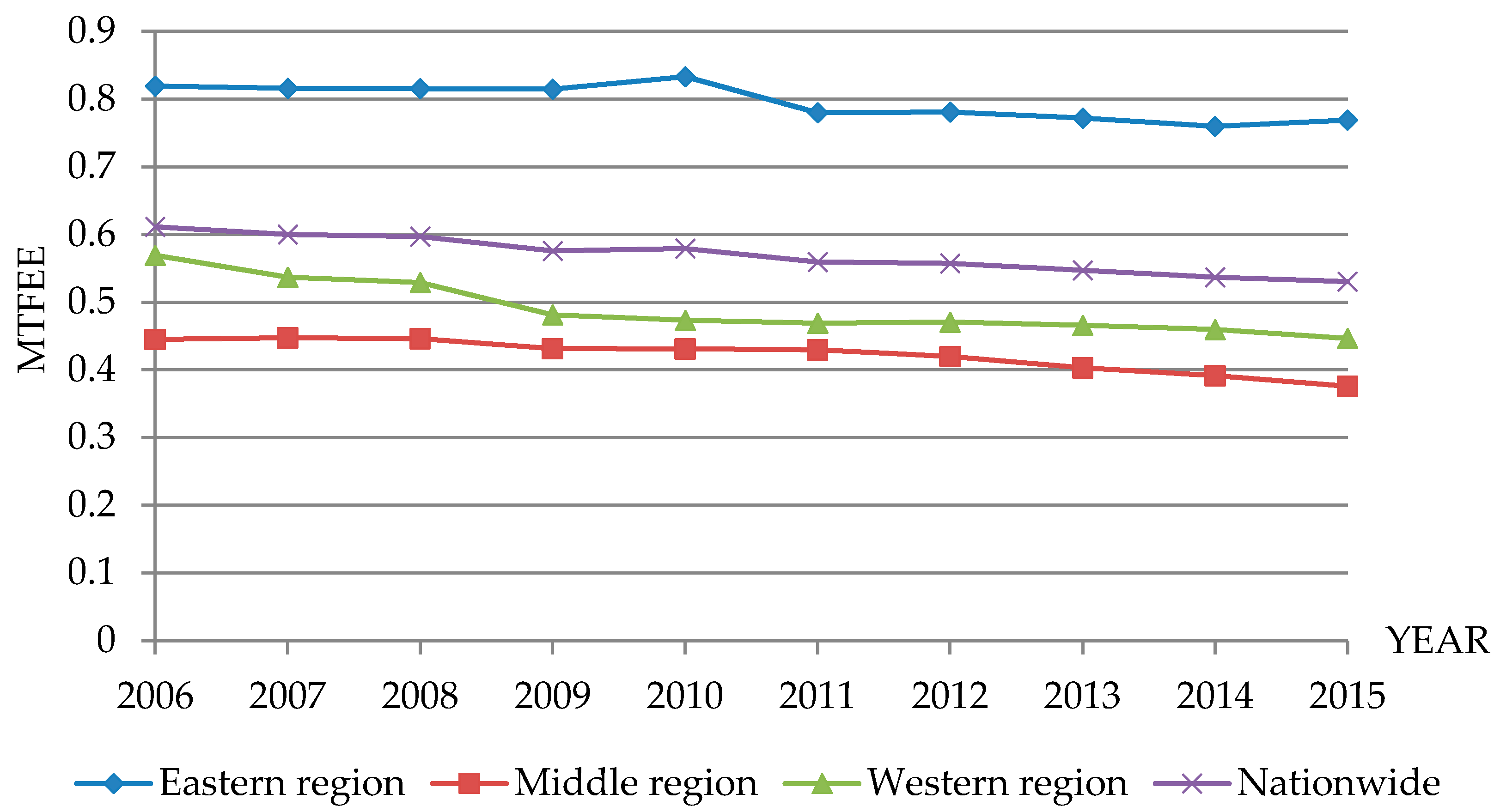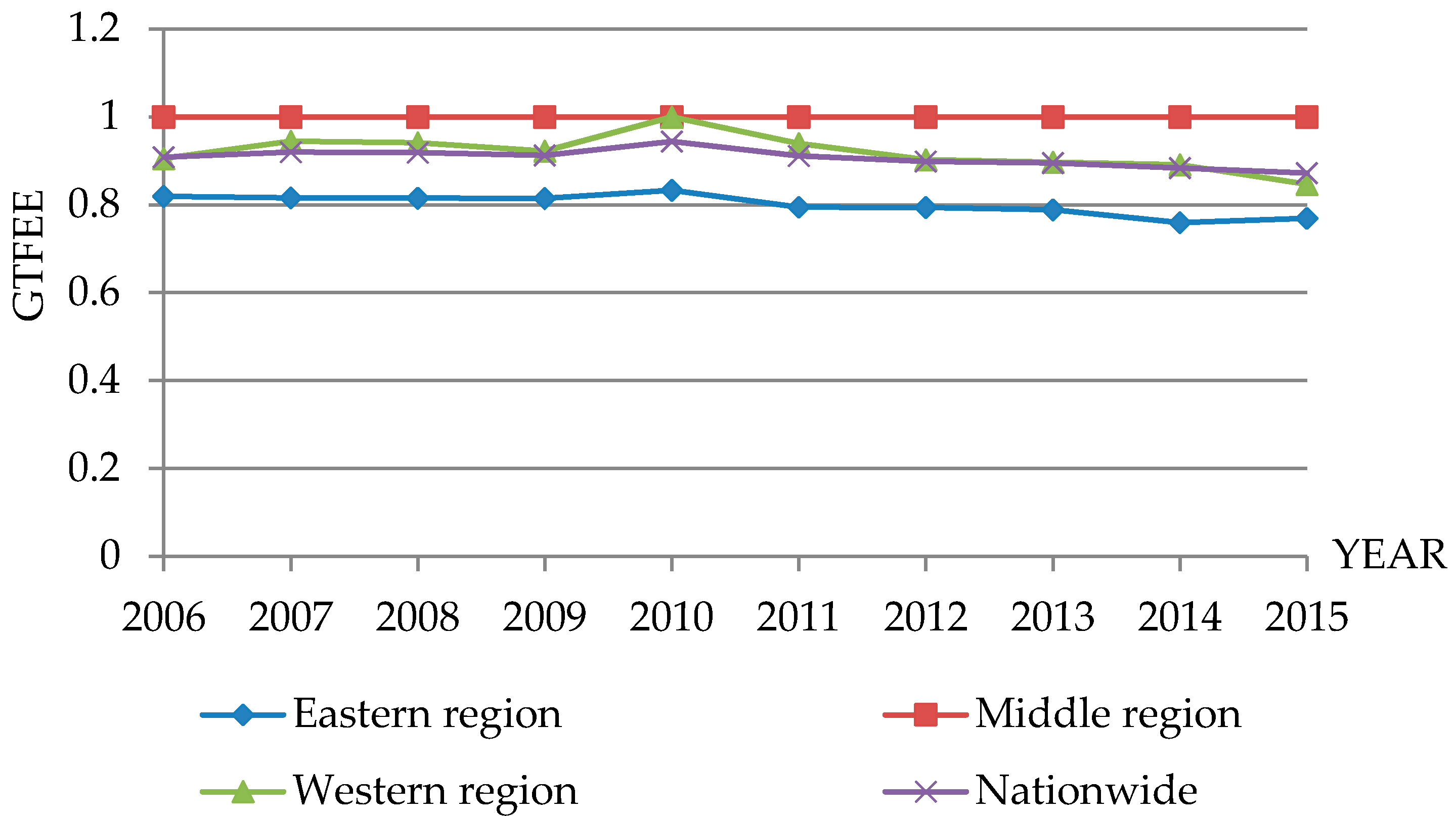The Impact of Environmental Regulation on Total Factor Energy Efficiency: A Cross-Region Analysis in China
Abstract
:1. Introduction
2. Methodology
2.1. Meta-Frontier and Group Frontier Production Function
2.2. SBM-Undesirable Model
2.3. Tobit Regression Model
3. Total Factor Energy Efficiency
3.1. Sample, Variables, and Data
- (1).
- Labor input is represented by labor force consumption, i.e., by the average employment figure in provinces at the beginning and end of the year.
- (2).
- Capital input is represented by capital consumption in provinces. There is no capital stock as official data in the China Yearbooks, so we converted the capital stock data into the 2005 constant price by using Zhang et al.’s [43] perpetual inventory method.
- (3).
- Energy input is represented by energy consumption in standard coal units.
- (4).
- Desirable output is represented by the real GDP of each province, calculated as constant prices for 2005 according to the GDP deflator conversion.
- (5).
- Undesirable outputs contain SO2 emissions and chemical oxygen demand, both in units of 10,000 tons.
3.2. Total Factor Energy Efficiency (TFEE) under Different Frontiers
4. Empirical Analysis
4.1. Selection of Influencing Factors
4.2. Empirical Results and Analysis
5. Conclusions
- (1).
- During 2006 to 2015, the overall levels of TFEE under the group frontier and the meta-frontier in China were low. Thus, great potential for improving energy efficiency exists. Throughout the regions in China, TFEE is significantly imbalanced.
- (2).
- Environmental regulations have not only direct but also indirect effects on TFEE through technological progress and opening degree. Because of the different levels of economic and social development, how environmental regulations impact TFEE varies from region to region.
6. Future Policy Recommendation
- (1).
- Implementing regional differentiated environmental regulation policies: Due to the regional differences in development, China should implement differentiated environmental regulation policies in accordance with the environmental and economic responsibilities of the different regions. In the eastern region, a relatively stringent environmental regulation policy should be implemented, whereas in the middle and western regions, the enterprise access mechanism can be appropriately relaxed on the basis of full consideration of the environmental carrying capacity.
- (2).
- Increasing investment in innovation of energy-saving and emissions-reduction technology: Investment in technological innovation should focus on promoting the development and application of energy-saving and emissions-reduction technology. Increased investment will encourage enterprises to innovate technology, purchase advanced equipment, and introduce foreign advanced energy-saving management practices. At the same time, the government needs to rein in the rebound effect through leverage such as an energy tax.
- (3).
- Constructing a regional compensation mechanism for environmental protection: In the process of implementing environmental regulation, the cost of regional environmental protection should be allocated rationally. When accepting industrial transfers or foreign direct investment, all regions should agree on the compensation mechanism for environmental protection according to the polluter pays principle. For the poverty-stricken and ecologically fragile areas in the middle and western regions, the government should strengthen its planning and guidance to encourage the full provision of regional environmental public goods and thus gradually promote TFEE.
Acknowledgments
Author Contributions
Conflicts of Interest
References
- Soytas, U.; Sari, R. Energy consumption and gdp: Causality relationship in g-7 countries and emerging markets. Energy Econ. 2003, 25, 33–37. [Google Scholar] [CrossRef]
- Crompton, P.; Wu, Y. Energy consumption in China: Past trends and future directions. Energy Econ. 2005, 27, 195–208. [Google Scholar] [CrossRef]
- Fisher-Vanden, K.; Jefferson, G.H.; Liu, H.; Tao, Q. What is driving China’s decline in energy intensity? Resour. Energy Econ. 2004, 26, 77–97. [Google Scholar] [CrossRef]
- Sinton, J.E.; Levine, M.D. Changing energy intensity in Chinese industry: The relatively importance of structural shift and intensity change. Energy Policy 1994, 22, 239–255. [Google Scholar] [CrossRef]
- Chang, M.-C. A comment on the calculation of the total-factor energy efficiency (TFEE) index. Energy Policy 2013, 53, 500–504. [Google Scholar] [CrossRef]
- Hu, J.-L.; Wang, S.-C. Total-factor energy efficiency of regions in China. Energy Policy 2006, 34, 3206–3217. [Google Scholar] [CrossRef]
- Aigner, D.; Lovell, C.K.; Schmidt, P. Formulation and estimation of stochastic frontier production function models. J. Econ. 1977, 6, 21–37. [Google Scholar] [CrossRef]
- Battese, G.E.; Coelli, T.J. A model for technical inefficiency effects in a stochastic frontier production function for panel data. Empir. Econ. 1995, 20, 325–332. [Google Scholar] [CrossRef]
- Seiford, L.M.; Thrall, R.M. Recent developments in dea: The mathematical programming approach to frontier analysis. J. Econ. 1990, 46, 7–38. [Google Scholar] [CrossRef]
- Cook, W.D. Data envelopment analysis: A comprehensive text with models, applications, references and dea-solver software. JSTOR 2001, 31, 116–118. [Google Scholar]
- Zhou, P.; Poh, K.L.; Ang, B.W. Data envelopment analysis for measuring environmental performance. In Handbook of Operations Analytics Using Data Envelopment Analysis; Springer: Berlin, Germany, 2016; pp. 31–49. [Google Scholar]
- Babazadeh, R.; Razmi, J.; Rabbani, M.; Pishvaee, M.S. An integrated data envelopment analysis–mathematical programming approach to strategic biodiesel supply chain network design problem. J. Clean. Prod. 2017, 147, 694–707. [Google Scholar] [CrossRef]
- Pittman, R.W. Multilateral productivity comparisons with undesirable outputs. Econ. J. 1983, 93, 883–891. [Google Scholar] [CrossRef]
- Färe, R.; Grosskopf, S.; Lovell, C.K.; Pasurka, C. Multilateral productivity comparisons when some outputs are undesirable: A nonparametric approach. Rev. Econ. Stat. 1989, 71, 90–98. [Google Scholar] [CrossRef]
- Hailu, A.; Veeman, T.S. Non-parametric productivity analysis with undesirable outputs: An application to the canadian pulp and paper industry. Am. J. Agric. Econ. 2001, 83, 605–616. [Google Scholar] [CrossRef]
- Seiford, L.M.; Zhu, J. Modeling undesirable factors in efficiency evaluation. Eur. J. Oper. Res. 2002, 142, 16–20. [Google Scholar] [CrossRef]
- Färe, R.; Grosskopf, S. Nonparametric productivity analysis with undesirable outputs: Comment. Am. J. Agric. Econ. 2003, 85, 1070–1074. [Google Scholar] [CrossRef]
- Tone, K. A slacks-based measure of efficiency in data envelopment analysis. Eur. J. Oper. Res. 2001, 130, 498–509. [Google Scholar] [CrossRef]
- Tone, K. Dealing with Undesirable Outputs in Dea: A Slacks-Based Measure (SBM) Approach; GRIPS Research Report Series; National Graduate Institute for Policy Studies: Tokyo, Japan, 2003. [Google Scholar]
- Cooter, R.D. The coase theorem. In Allocation, Information and Markets; Springer: Berlin, Germany, 1989; pp. 64–70. [Google Scholar]
- Bel, G.; Costas, A. Do public sector reforms get rusty? Local privatization in Spain. J. Policy Reform 2006, 9, 1–24. [Google Scholar] [CrossRef]
- Jorgenson, D.W.; Wilcoxen, P.J. Environmental regulation and us economic growth. Rand J. Econ. 1990, 21, 314–340. [Google Scholar] [CrossRef]
- Barbera, A.J.; McConnell, V.D. The impact of environmental regulations on industry productivity: Direct and indirect effects. J. Environ. Econ. Manag. 1990, 18, 50–65. [Google Scholar] [CrossRef]
- Qinghuang, H.; Ming, G. A research on the energy conservation and emission reduction effect of China’s environmental regulation tools. Sci. Res. Manag. 2016, 6, 003. [Google Scholar]
- Zhou, X.; Feng, C. The impact of environmental regulation on fossil energy consumption in China: Direct and indirect effects. J. Clean. Prod. 2017, 142, 3174–3183. [Google Scholar] [CrossRef]
- Zhu, Q. A perspective of evolution for carbon emissions trading market: The dilemma between market scale and government regulation. Discret. Dyn. Nat. Soc. 2017, 2017, 1432052. [Google Scholar] [CrossRef]
- Sinn, H.-W. Public policies against global warming: A supply side approach. Int. Tax Public Financ. 2008, 15, 360–394. [Google Scholar] [CrossRef]
- Porter, M.E. Competitive Strategy: Techniques for Analyzing Industries and Competitors; Simon and Schuster: New York, NY, USA, 2008. [Google Scholar]
- Jaffe, A.B.; Palmer, K. Environmental regulation and innovation: A panel data study. Rev. Econ. Stat. 1997, 79, 610–619. [Google Scholar] [CrossRef]
- Saunders, H.D. The khazzoom-brookes postulate and neoclassical growth. Energy J. 1992, 13, 131–148. [Google Scholar] [CrossRef]
- Einhorn, M. Economic implications of mandated efficiency standards for household appliances: An extension. Energy J. 1982, 3, 103–109. [Google Scholar] [CrossRef]
- Brookes, L. The energy price fallacy and the role of nuclear power in the UK. Energy Policy 1978, 6, 94–106. [Google Scholar] [CrossRef]
- Zghidi, N.; Mohamed Sghaier, I.; Abida, Z. Does economic freedom enhance the impact of foreign direct investment on economic growth in north African countries? A panel data analysis. Afr. Dev. Rev. 2016, 28, 64–74. [Google Scholar] [CrossRef]
- Boontem, K. An impact of pollution control enforcements on fdi inflow. Bus. Manag. Rev. 2016, 7, 155. [Google Scholar]
- O’Donnell, C.J.; Rao, D.P.; Battese, G.E. Metafrontier frameworks for the study of firm-level efficiencies and technology ratios. Empir. Econ. 2008, 34, 231–255. [Google Scholar] [CrossRef]
- Brännlund, R.; Färe, R.; Grosskopf, S. Environmental regulation and profitability: An application to Swedish pulp and paper mills. Environ. Resour. Econ. 1995, 6, 23–36. [Google Scholar] [CrossRef]
- Tobin, J. Estimation of relationships for limited dependent variables. Econ. J. Econ. Soc. 1958, 26, 24–36. [Google Scholar] [CrossRef]
- Anastasopoulos, P.C.; Tarko, A.P.; Mannering, F.L. Tobit analysis of vehicle accident rates on interstate highways. Accid. Anal. Prev. 2008, 40, 768–775. [Google Scholar] [CrossRef] [PubMed]
- Cobb, C.W.; Douglas, P.H. A theory of production. Am. Econ. Rev. 1928, 18, 139–165. [Google Scholar]
- Inglesi-Lotz, R. The impact of renewable energy consumption to economic growth: A panel data application. Energy Econ. 2016, 53, 58–63. [Google Scholar] [CrossRef]
- Papageorgiou, C.; Saam, M.; Schulte, P. Substitution between clean and dirty energy inputs: A macroeconomic perspective. Rev. Econ. Stat. 2017, 99, 281–290. [Google Scholar] [CrossRef]
- Reynès, F. The Cobb-Douglas Function as a Flexible Function: Analysing the Sustitution between Capital, Labor and Energy; SciencesPo: Paris, France, 2017. [Google Scholar]
- Jun, Z.; Guiying, W.; Jipeng, Z. The estimation of China’s provincial capital stock: 1952—2000. Econ. Res. J. 2004, 10, 35–44. [Google Scholar]
- Liu, G.; Yang, Z.; Chen, B.; Zhang, Y.; Su, M.; Ulgiati, S. Prevention and control policy analysis for energy-related regional pollution management in China. Appl. Energy 2016, 166, 292–300. [Google Scholar] [CrossRef]
- Robinson, J.A.; Torvik, R.; Verdier, T. The political economy of public income volatility: With an application to the resource curse. J. Public Econ. 2017, 145, 243–252. [Google Scholar] [CrossRef]
- Amir, R.; Gama, A.; Werner, K. On environmental regulation of oligopoly markets: Emission versus performance standards. Environ. Resour. Econ. 2017, 1–21. [Google Scholar] [CrossRef]
- Demmig-Adams, B.; Stewart, J.J.; Adams, W.W. Environmental regulation of intrinsic photosynthetic capacity: An integrated view. Curr. Opin. Plant Biol. 2017, 37, 34–41. [Google Scholar] [CrossRef] [PubMed]
- Jianhui, H. Can intensive environmental regulation promote the upgrading of industrial structure? A research based on different kinds of environmental regulation. J. Environ. Econ. 2016, 2, 008. [Google Scholar]




| Eastern Region (i = 1) | Middle Region (i = 2) | Western Region (i = 3) | |||
|---|---|---|---|---|---|
| j | Provinces | j | Provinces | j | Provinces |
| 1 | Beijing | 1 | Shanxi | 1 | Neimenggu |
| 2 | Tianjin | 2 | Jilin | 2 | Guangxi |
| 3 | Hebei | 3 | Heilongjiang | 3 | Chongqing |
| 4 | Liaoning | 4 | Anhui | 4 | Sichuang |
| 5 | Shanghai | 5 | Jiangxi | 5 | Guizhou |
| 6 | Jiangsu | 6 | Henan | 6 | Yunnan |
| 7 | Zhejiang | 7 | Hubei | 7 | Shanxi |
| 8 | Fujian | 8 | Hunan | 8 | Gansu |
| 9 | Shandong | 9 | Qinghai | ||
| 10 | Guangdong | 10 | Ningxia | ||
| 11 | Hainan | 11 | Xinjiang | ||
| Category | Variable | Unit |
|---|---|---|
| Inputs (x) | Labor force consumption | 10,000 persons |
| Capital consumption | 100 million Yuan | |
| Energy consumption | 10,000 tons of SCE | |
| Desirable output (yg) | Gross domestic product | 100 million Yuan |
| Undesirable outputs (yb) | SO2 emission | 10,000 tons |
| Chemical oxygen demand | 10,000 tons |
| Eastern Region | Group Frontier | Meta-Frontier | Middle Region | Group Frontier | Meta-Frontier | Western Region | Group Frontier | Meta-Frontier |
|---|---|---|---|---|---|---|---|---|
| Beijing | 1.000 | 1.000 | Shanxi | 1.000 | 0.350 | Neimenggu | 1.000 | 0.388 |
| Tianjin | 1.000 | 0.952 | Jilin | 1.000 | 0.390 | Guangxi | 1.000 | 0.444 |
| Hebei | 0.399 | 0.399 | Heilongjiang | 1.000 | 0.441 | Chongqing | 1.000 | 0.443 |
| Liaoning | 0.439 | 0.439 | Anhui | 1.000 | 0.450 | Sichuang | 1.000 | 0.398 |
| Shanghai | 0.978 | 0.978 | Jiangxi | 1.000 | 0.438 | Guizhou | 0.836 | 0.364 |
| Jiangsu | 0.912 | 0.912 | Henan | 1.000 | 0.400 | Yunnan | 0.797 | 0.489 |
| Zhejiang | 0.750 | 0.750 | Hubei | 1.000 | 0.452 | Shanxi | 1.000 | 0.425 |
| Fujian | 0.549 | 0.549 | Hunan | 1.000 | 0.455 | Gansu | 0.868 | 0.391 |
| Shandong | 0.778 | 0.778 | Qinghai | 1.000 | 1.000 | |||
| Guangdong | 1.000 | 1.000 | Ningxia | 0.846 | 0.664 | |||
| Hainan | 1.000 | 1.000 | Xinjiang | 0.764 | 0.385 | |||
| Average | 0.800 | 0.796 | 1.000 | 0.422 | 0.919 | 0.490 |
| Eastern Region | TGR | Middle Region | TGR | Western Region | TGR |
|---|---|---|---|---|---|
| Beijing | 1.000 | Shanxi | 0.350 | Neimenggu | 0.388 |
| Tianjin | 0.952 | Jilin | 0.390 | Guangxi | 0.444 |
| Hebei | 1.000 | Heilongjiang | 0.441 | Chongqing | 0.443 |
| Liaoning | 1.000 | Anhui | 0.450 | Sichuang | 0.398 |
| Shanghai | 1.000 | Jiangxi | 0.438 | Guizhou | 0.459 |
| Jiangsu | 1.000 | Henan | 0.400 | Yunnan | 0.599 |
| Zhejiang | 1.000 | Hubei | 0.452 | Shanxi | 0.425 |
| Fujian | 1.000 | Hunan | 0.455 | Gansu | 0.464 |
| Shandong | 1.000 | Qinghai | 1.000 | ||
| Guangdong | 1.000 | Ningxia | 0.804 | ||
| Hainan | 1.000 | Xinjiang | 0.531 | ||
| Average | 0.996 | 0.422 | 0.541 |
| Variable | National | Eastern Region | Middle Region | Western Region |
|---|---|---|---|---|
| −0.0511 ** | 0.0219 ** | −0.0030 ** | −0.1066 ** | |
| (−2.05) | (2.03) | (2.16) | (−2.30) | |
| −0.1691 * | 0.0136 *** | −0.3128 *** | −2.459 *** | |
| (−1.78) | (3.03) | (-9.48) | (−3.22) | |
| −0.1269 *** | −0.2435 ** | −0.0455 ** | −0.2165 *** | |
| (−2.99) | (−2.03) | (−2.22) | (−3.31) | |
| −0.4425 | −0.2427 | −0.0051 | −0.2690 | |
| (−0.56) | (−0.87) | (−0.07) | (−0.88) | |
| −0.0136 | −0.1330 *** | 0.0082 | 0.2226 | |
| (−0.58) | (−3.14) | (0.66) | (1.40) | |
| 0.0664 * | −0.0778 * | 0.0639 ** | 0.6890 * | |
| (1.62) | (−1. 83) | (2.13) | (1.66) | |
| 0.0209 * | 0.2168 *** | −0.0035 | −0.3847 ** | |
| (1.91) | (3.12) | (−0.21) | (−2.03) | |
| 1.4905 *** | 2.1293 | 2.1372 *** | 11.6877 *** | |
| (2.82) | (1.09) | (9.33) | (3.63) | |
| 0.3709 *** | 0.5010 *** | 0.0405 *** | 0.4293 ** | |
| (5.83) | (2.67) | (3.70) | (2.02) | |
| 0.0951 *** | 0.1302 *** | 0.0220 *** | 0.2771 *** | |
| (19.50) | (8.54) | (11.93) | (5.77) | |
| 0.9384 | 0.9367 | 0.7718 | 0.7059 |
© 2017 by the authors. Licensee MDPI, Basel, Switzerland. This article is an open access article distributed under the terms and conditions of the Creative Commons Attribution (CC BY) license (http://creativecommons.org/licenses/by/4.0/).
Share and Cite
Lin, J.; Xu, C. The Impact of Environmental Regulation on Total Factor Energy Efficiency: A Cross-Region Analysis in China. Energies 2017, 10, 1578. https://doi.org/10.3390/en10101578
Lin J, Xu C. The Impact of Environmental Regulation on Total Factor Energy Efficiency: A Cross-Region Analysis in China. Energies. 2017; 10(10):1578. https://doi.org/10.3390/en10101578
Chicago/Turabian StyleLin, Jianting, and Changxin Xu. 2017. "The Impact of Environmental Regulation on Total Factor Energy Efficiency: A Cross-Region Analysis in China" Energies 10, no. 10: 1578. https://doi.org/10.3390/en10101578
APA StyleLin, J., & Xu, C. (2017). The Impact of Environmental Regulation on Total Factor Energy Efficiency: A Cross-Region Analysis in China. Energies, 10(10), 1578. https://doi.org/10.3390/en10101578





